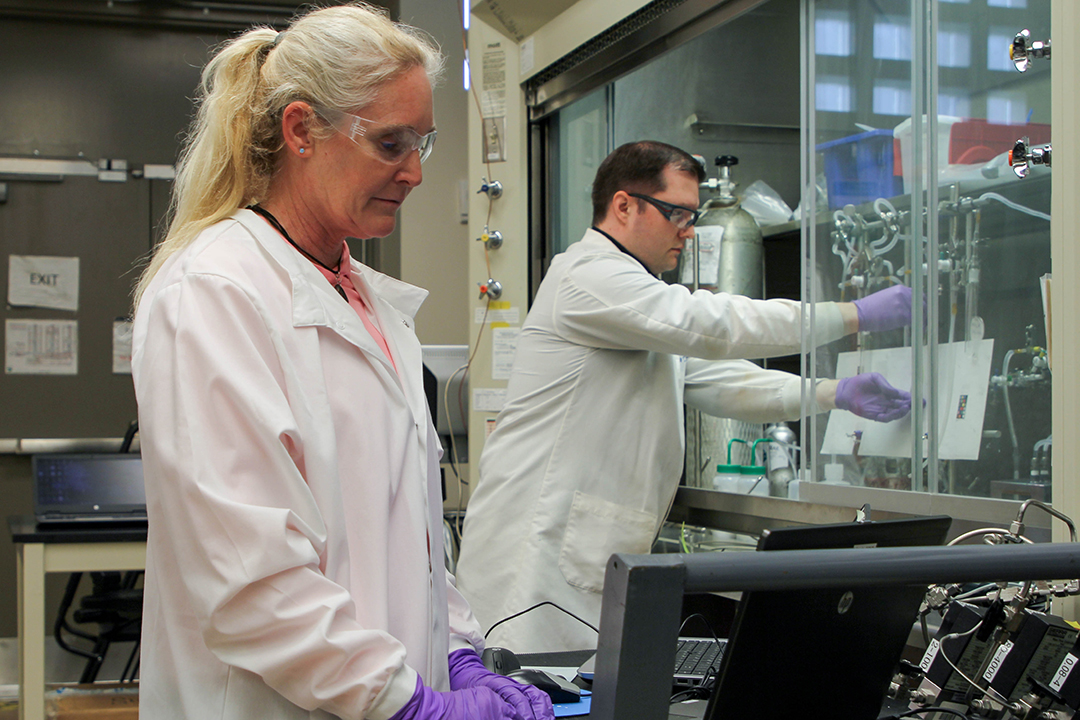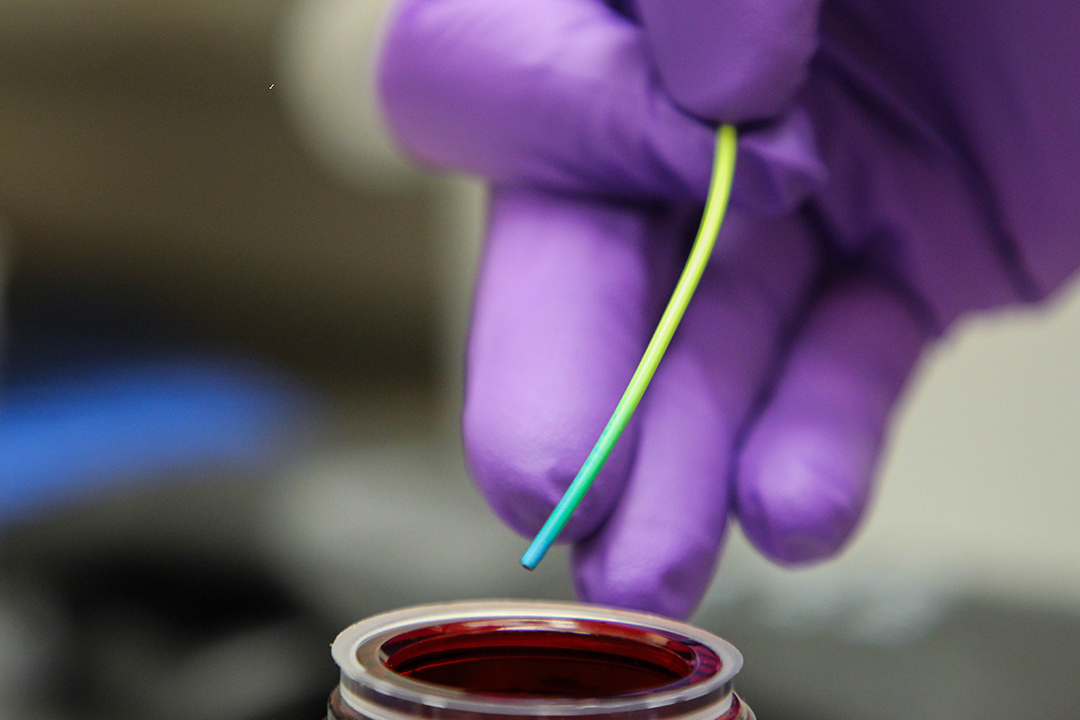// NEWS RELEASE
DEVCOM CBC Researchers Explore 3D Printed Sensors
CCDC Chemical Biological Center Public Affairs | April 9th, 2024
DEVCOM CBC Researchers Explore 3D Printed Sensors
DEVCOM CBC Public AffairsApril 9th, 2024

Research chemist Dr. Brian Hauck and biologist Melissa Dixon set up a vapor generator to test one of the ChROMa samples by exposing it to ammonium hydroxide vapor. (U.S. Army photo by Ellie White)
Aberdeen Proving Ground, MD – Dr. Brian Hauck, a U.S. Army Combat Capabilities Development Command Chemical Biological Center (DEVCOM CBC) research chemist, and his research team started out with a question: What if you could 3D print a sensor that changed color in the presence of chemical warfare agents and toxic industrial chemicals?
If it worked, it would be on-demand, low cost, small, very light, easy to carry and easy for a warfighter or first responder to use.
That is just the kind of high-risk, high-reward idea that DEVCOM CBC provides seed money to explore. Hauck and his research team received a grant of $30,000 to find out.
The source of that seed money was DEVCOM CBC’s ‘Quick Empowerment leads to Successful Tomorrows’ Program, or QUEST for short. There are no limits on ideas that can qualify for funding, so long as the idea is tied to DEVCOM CBC’s mission. Projects of any size from $5,000 to $100,000 are considered. Applicants get 10 minutes to pitch their idea before members of Center leadership followed by five minutes for questions. Hauck and his team were one of 12 pitches out of 26 to receive funding in 2023.
The goal was to take commercially available filament for fused deposition modeling, the most common form of 3D printing, and figure out how to embed a colorimetric indicator into it to make it change color, much like a pH strip. They named the system Chemically Reactive On-demand Materials, or ChROMa for short.

The research team used their grant to develop this procedure by soaking a sample of filament in a liquid indicator and then drying it out. The optimum times for the soaking and drying stages had to be determined, as well as which type of filament then exhibited the greatest degree of color change when exposed to chemical vapor. That involved experimenting with different plastics such as nylon, polylactic acid, and acrylonitrile butadiene styrene, in their original formulation or with different additives such as white dye or glass fiber.
Given these variables to work with, the number of possible experiments was more than 300. They were able to cut that number to 90 using a method known as Design of Experiment — a technique using statistical analysis to determine the relationship between factors affecting a process – to reduce the number of experiments needed.
They discovered that the best material was a white nylon that had been soaked for 15 minutes and dried for four hours. Having proved the concept, they would like to move on to experimenting with novel colorimetric chemistries, compounding the indicator and plastic together, and testing it on a 3D printer. The goal would be to create a spool of colorimetric filament that retains its colorimetric sensing capacity during the 3D printing process. This would ultimately lead to experimentation with the form factor—for example, could you print a sensor in the shape of a credit card?
However, Hauck is very satisfied with his team’s work thus far. “Whenever you come up with an idea like this there is always the possibility that it simply won’t work,” he said. “It’s a great sense of accomplishment when everyone and everything comes together to make it work, and now we have a lot of exciting possibilities to explore.”
The Defense Logistics Agency (DLA) has already expressed interest in the research. ChROMa holds the potential for easing the logistical burden of providing field sensors to warfighters if 3D printers and materials can be deployed near the front to create custom sensors and form factors that suit the mission at hand.
The team plans to submit their work on ChROMa thus far to the DLA’s Emergent IV Broad Agency Announcement, a funding program for scientific study and experimentation directed toward advancing the state-of-the-art or increasing knowledge or understanding in additive manufacturing.
The U.S. Army Combat Capabilities Development Command (DEVCOM) leads in the discovery, development and delivery of technology-based capabilities to enable Soldiers to win our nation’s wars and come home safely. DEVCOM is a major subordinate command of the U.S. Army Futures Command. The DEVCOM Chemical Biological Center is the Army’s principal research and development center for chemical and biological defense technology, engineering and field operations. The DEVCOM Chemical Biological Center is headquartered at Aberdeen Proving Ground, Maryland.
